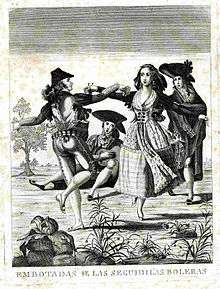Seguidilla

The seguidilla is an old Castilian folksong and dance form in quick triple time. (The dance portion is spelt in the plural, as seguidillas.) The song is generally in the major key and often begins on an off-beat. The name is a diminutive of seguida (from seguir, meaning "to follow").[1]
Types
The earliest and most influential of the types of seguidilla are thought to originate in either La Mancha or Andalusia, having become typical of large parts of central Spain. Variants include the seguidilla manchega (from La Mancha) as well as the murciana from Murcia and the slightly faster sevillana of Seville. One of the most complex styles of seguidilla is the seguidilla flamenca or seguiriya), which is used in flamenco music. Act I of Jacques Offenbach's opera La Périchole includes a number entitled "Séguedille".
Dance
The dance is performed in pairs with animated footwork reflecting the rhythm of the guitar and percussion, yet restrained upper body movement. One technique characteristic of the dance is known as bien parado, wherein the dancers stop motion at the end of a section of the music or stanza of text while the instruments continue playing into the next section. Usually the woman dance also holds castanets.
Act I of ballet Don Quixote (classical version choreographed by Marius Petipa and restaged by Alexander Gorsky) includes a Seguidilla dance performed by corps de ballet.
Song
In general, seguidilla folksongs begin with a brief instrumental introduction, often played on guitar, followed by a salida, which is a small portion of the song text acting as a false start. The remaining sections are free and varied, consisting of instrumental interludios and the vocal sections called coplas.
Seguidilla aria
The Seguidilla aria forms part of Act I of the French opera, Carmen by Georges Bizet. The beautiful gypsy, Carmen, sings it in an attempt to seduce her captor, the soldier Don José, into going with her to her friend Lillas Pastia's inn. [2] It is likely also that the "Veil Song" (Act II, scene 1, of Don Carlos) by Giuseppe Verdi is meant to evoke the style of a seguidilla. Moreover, in Verdi's La forza del destino, the composer inserts a folkdance at the beginning of Act II, and calls it seguidilla on the score. However, this passage is written in 4/4, not in triple time as seguidilla traditionally is. A Seguidilla aria also features in Paisiello's opera Il barbiere di Siviglia.
Notes
- ↑ "seguidilla". Merriam-Webster Dictionary.. Accessed May 2008.
- ↑ Aria database Seguidilla ("Près des ramparts de Séville"). Accessed March 2008